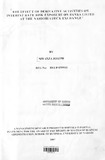| dc.description.abstract | This paper investigated whether the level of derivative activities IS associated with the market's perception of banks' interest rate and exchange rate risks. Data was collected from the population of all quoted banks at the Nairobi stock exchange which totaled to 7 banks which are in the financial segment. The data co11ected were in the form of stock return, market index return, long term and short term interest rates and other financial data extracted from the financial reports from 2001 to 2006, which included asset book value, interest income, notional values of derivatives and book value of equity among other variables. The data used in the study was co11ected from the Nairobi stock exchange, Central bank of Kenya and the Capital markets authority. Investigating the effect of derivative activities on banks' interest rate and exchange rate exposures involved a two stage procedure using the augmented market model developed by Yong et al (2003). The interest rate and exchange rate exposures are estimated in stage one and are then employed as the dependent variable in the stage two regressions. Using the entire population of quoted banks, in estimating the interest rate and exchange rate exposure, the study found a positive relationship between bank stock return and long term and short term interest rate and exchange rate. The study also found there was a negative association between the banks return and short term interest rite. on one hand while a positive association between the banks return and long term interest rate(correlation coefficients) The study also found that the level of derivative activities(TDER) was positively associated with long-term interest rate exposures but negatively associated with short-term interest rate and exchange rate exposure. This suggests that the level of derivative activities in banks increases long-term interest rate exposure. Possible explanation for this finding include banks use derivatives to speculate long-term interest rate changes or that banks derivative trading activities has exposed them to long-term interest rate that are not effectively hedged. An alternative explanation is that long-term interest rate exposure is difficult to hedge relative to short-term interest rate exposure because of the lack of liquidity associated with long-term interest rate instruments. | en |

